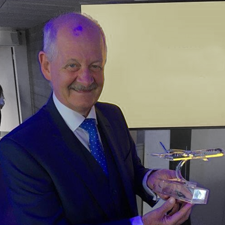It is no surprise that the global COVID-19 pandemic has posed unprecedented challenges to global industries, and the air transport sector is with no exception. With borders closed, national lockdowns and a slump in consumer demand, it has undoubtedly been the most challenging time in air transport’s history.
With 2020 passenger numbers down by 60% compared to the same period in 2019, parked aircraft and empty airports have become an unsightly reminder of the times we are in today. With experts forecasting global air traffic will not return to pre-coronavirus levels until at least 2024, the UK CAA believes risk and outcome-based oversight and surveillance are ever more important for restarting air operations.
Preparing to restart air operations in the wake of COVID-19 is vital for the successful revival of civil aviation. But this is no simple task. As well as navigating complex logistical, operational, financial and political hurdles, industry organizations and civil aviation authorities need to adhere to international aviation safety and security standards – even in the so-called ‘new normal’.
This article shares some of the UK CAA’s latest thinking, advice, and top tips for regulators and aviation entities planning to restart air operations during or after a global pandemic.
![]() Aviation Security
Aviation Security
Kevin Sawyer, Senior Manager – Aviation Security Development
COVID-19 has created significant disruption and uncertainty for our sector, and the impact this has had on the potential risks we face and vulnerabilities we manage should not be underestimated.
Whilst it may be tempting to conclude that the reduction in regular operations correlates to a reduced likelihood of unlawful interference, we are continuing to witness a sustained demand for and reliance upon cargo operations to facilitate the movement of essential and emergency supplies. This complexity serves to highlight the need for regulators to be flexible and adaptable in their oversight methodology – moving away from a ‘one-size-fits-all’ approach to a system that not only manages risk but also enables entities to continue to function in these challenging times.
Human factors associated with returning to security operations after an extended absence must also be considered – the likely ‘skill fade’ experienced by security officers in highly specialized roles, combined with changes to the operating environment should not be underestimated. Both industry organizations and regulators must adopt an agile and risk-based approach to aviation security focusing on outcomes, as the ‘direct and inspect’ model is neither feasible in the short-term nor sustainable in the medium and long term.
In addition to this vigilant risk management approach, embedding public health measures into our daily operations must be factored into our overall security strategy to ensure the health and security cultures can co-exist. In the ICAO Year of Security Culture, it is more important now than ever that security is embedded into our ‘DNA’ and everyone takes responsibility for security.
![]() Aerodrome Operations
Aerodrome Operations
John Muir, Aerodrome Inspector
Airports have experienced drastic changes such as never seen before. Overnight, they essentially became luxury aircraft parking facilities. In some cases, delayed aerodrome maintenance and wildlife hazard activities have been postponed, and aircraft remain parked where they normally are not. In other cases, we have seen various changes to terminal and apron operations at several UK airports.
As we plan for the restart, airport operations need to be restored to a safe level before the industry can restart, recognizing that operations will remain restricted and liable to sudden changes as States make public health decisions. Aerodrome staff that were stood down may no longer be current. Staff who have worked throughout the period may be fatigued, and stress levels will be higher than normal.
To mitigate these issues in an operationally challenging and resource-constrained environment, airports, air navigation service providers and regulators must cooperate, communicate and collaborate using safety management and risk-based decision-making principles to ensure a safe restart and recovery. The ICAO Recovery Platform and associated guidance is an excellent tool for CAAs and industry organizations looking to overcome audit programme disruptions, easements or variations to regulations in areas such as RFFS Training and exercising, ATC training and competency.
![]() Flight Operations
Flight Operations
Richard Miller, Senior Technical Advisor
Air Transport Operators have faced a wide range of operational challenges, including economic and human factors related considerations, as they manage a safe restart and recovery.
A core flight operations related element has been the management of staff competencies, within the backdrop of reduced resource levels and in certain cases, different types of operation. During restart, the conduct of training, possibly at different locations from where an air operator is usually based is just one element that needs consideration. Key to mitigating these and other challenges has been the cooperation, communication and collaboration between regulators and industry to ensure the most effective risk-based surveillance approach is taken. A key element of this approach has been effective engagement in the management of change to ensure actions are robust and subject to continuous review.
The pandemic has presented flight operations human factors considerations. There continues to be a need for a high degree of human factors awareness; from the promotion and management of staff wellbeing to the assessment of new procedures introduced during the restart phase of operations.
Regulators and industry stakeholders should work together to implement restart measures, and in doing so, account for core established safety management principles to ensure a safe harmonized approach. Process points include the need for early engagement on operational and other relevant issues, regular contact between regulator and industry, and the need to maintain a high degree of awareness of published guidance and other sources of information from a wide range of stakeholders. It is measures such as these that will help ensure that the restart and recovery in air operations are thoroughly considered and implemented in a structured manner.
![]() Airworthiness
Airworthiness
Graham Wheeler, Senior Technical Advisor
COVID-19 has impacted almost every entity in the aircraft production and manufacturing supply chain. Registered aircraft that have been parked for long periods present new safety risks and challenges that both operators and regulators may not have had to manage before.
Before the pandemic, operators and aircraft owners would plan the retirement or long-term parking of aircraft based on planned flying schedules. Covid-19 and its rapid impact have not allowed for this planning, and many aircraft were parked up at short notice – often at less than ideal sites. Initially, the length of parking would have been unknown as operators would have hoped to fly these aircraft after a short downtime. As the public health crisis unfolded, this generally was not the case, and aircraft have been parked for long periods. To ensure the continued airworthiness of aircraft, operators must follow manufactures guidance and ensure close coordination with their regulatory authority on when these aircraft will be prepared for return into service.
Civil Aviation Authorities have had the regulatory capability to flex some regulations temporarily to respond to unusual or unplanned events. As we plan to restart air operations, regulators must assess how some of these provisions have been used and any impact on their organization and air operations. It could be that some organizations shut down operations altogether. Normally, this would lead to suspension. In the UK, we have focused on developing good communication between the regulator and regulated entities and where necessary, agreed to hibernation for up to six months. Operators should only consider restarting air operations once they have shared their restart plan with their national regulator to ensure competence and compliance with international safety standards.
Get Prepared for Restarting Air Operations
Under the TRAINAIR PLUS programme, ICAO and CAA International have jointly developed a virtual classroom course aimed at enabling the safe and secure restart of air operations after a prolonged period of inactivity due to a major global health risk event. Entitled “CAA Preparation for Restarting Operations during a Pandemic”, the course provides senior management in aviation regulators and industry organizations with safety and security oversight and surveillance guidance during the recovery phase of a global pandemic, such as COVID-19.
The next delivery session of this course is scheduled for 26-29 April 2021.
CAA International (CAAi) is the technical cooperation arm of the UK Civil Aviation Authority. CAAi provides regulatory advice, training and capacity building programmes to aviation regulators and industry organisations across the globe. Drawing on leading expertise from within the UK regulator, CAAi helps organisations design, develop and implement regulatory best practice to comply with international regulatory standards. CAAi has worked in over 140 countries and trains over 2,500 aviation professionals each year.







